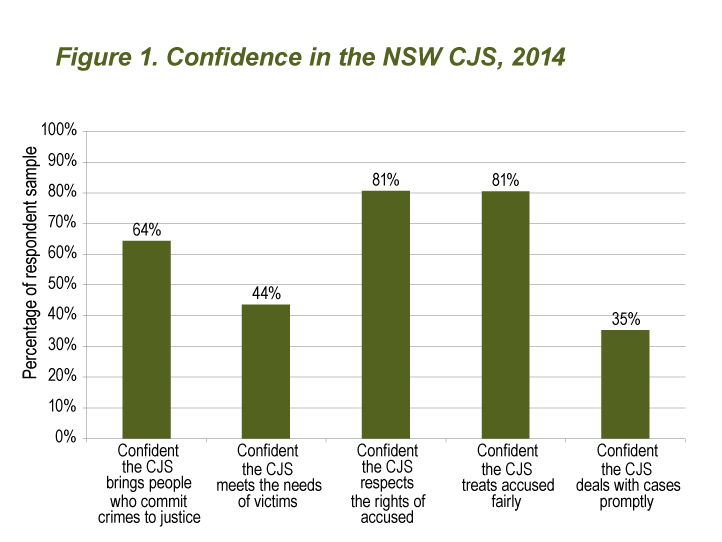CJB182
Public confidence in the New South Wales Criminal Justice System: 2014 update
|
Author
|
Imogen Halstead |
|
Published
|
February 2015 |
|
Report Type
|
Crime and Justice Bulletin No. 182 |
|
Subject
|
Sentencing
|
|
Keywords
|
Public confidence, sentencing, knowledge, media, cross-sectional survey |
Download this publication
Summary
Aim
To assess:
(1) the level of public confidence in the New South Wales (NSW) criminal justice system (CJS) in 2014,
(2) the relationship between confidence levels and individuals’ characteristics, including personal exposure to crime, and media consumption behaviours,
(3) how confidence in the NSW CJS has changed since 2007, and
(4) whether changes in confidence are associated with changing perceptions of crime and criminal justice outcomes.
Method
Data are sourced from a repeat cross-sectional survey of the NSW public (n=2,002 in 2007; n=2,001 in 2012; n=1,989 in 2014). Variation in confidence levels across the 2014 sample and over time is documented and tested for statistical significance. Basic logistic regression models are developed to predict respondents’ confidence as a function of their individual characteristics, and extended to control for variation in their perceptions of crime and justice outcomes.
Results
The results suggest that two out of every three NSW residents (64 per cent) are confident that the CJS brings people who commit crimes to justice. Just 44 per cent of residents are confident that the CJS meets the needs of victims, compared with 81 per cent confidence that the CJS treats individuals accused of committing crimes fairly and respects their rights. Most residents (66 per cent) believe sentences handed down are too lenient. One in three residents (35 per cent) are confident that the CJS deals with cases promptly. Personal exposure to crime is associated with lower levels of confidence in the CJS in general, and confidence also varies across groups with different media consumption habits. Since 2012, there has been a slight reduction in confidence around whether the CJS meets the needs of victims, and punitiveness appears to have intensified. Otherwise, public confidence in the justice system remained largely unchanged over this two-year window. Confidence is at higher levels than those recorded in 2007, and this partly reflects slight corrections in public perceptions of crime and justice outcomes.

Conclusion
Public confidence in the NSW CJS has improved since 2007, but pervasive misperceptions around crime trends and justice outcomes seemingly continue to undermine confidence. The magnitude of the media’s influence on confidence levels remains an open question.
Download this publication